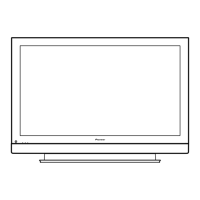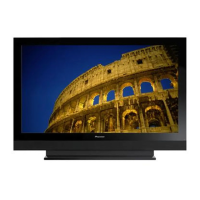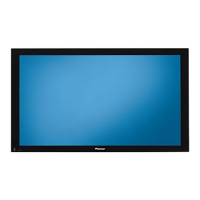Do you have a question about the Pioneer PDP-60MXE20 and is the answer not in the manual?
Provides an overview and context for the manual's content.
Details the key features and functionalities of the plasma display.
Lists the technical specifications of the plasma display.
Identifies and explains the various controls and connection ports.
Explains the functions of each button on the remote control.
Outlines the necessary conditions and safety precautions for the installation site.
Details environmental and operational conditions for installation.
Specifies the locations and types of mounting holes for installation.
Step-by-step guide for unpacking and preparing the unit.
Guides on connecting power and signal cables for proper setup.
Covers alternative installation methods beyond standard mounting.
Specifies guidelines for mounting the unit to various fittings.
Instructions and restrictions for wall-mounting the display.
Instructions for installing the unit upright and flush within a wall.
Describes the features and benefits of standard mounting hardware.
Provides guidelines for handling and installing mounting hardware.
Specific advice and responsibilities for installation professionals.
Details specifications and information for the video cards.
Lists the technical specifications for the video cards.
Step-by-step guide for installing the video cards.
Information about the table top stand accessory.
Step-by-step guide for assembling the table top stand.
Instructions for mounting the display onto the assembled stand.
Information about the wall mount unit accessory.
Details the assembly and attachment process for the wall mount.
Information about the speaker system accessory.
Step-by-step guide for installing the speaker system onto the display.
Prepares the user for adjustments by outlining methods and modes.
Explains the four operating modes of the display.
Maps input signals to screen sizes and formats.
Lists all adjustable settings available in Menu and Integrator modes.
Details basic operations possible in the normal display mode.
Explains controls like input switching and screen size adjustment.
Introduces the on-screen menu system for adjustments.
Provides a step-by-step walkthrough of a typical menu adjustment.
Details various settings like Color Temperature, DNR, and MPEG NR.
Manual adjustment of screen position, clock, and phase for optimal display.
Introduces the advanced adjustment mode for professional settings.
Explains how to enter, exit, and use the Integrator Mode.
Details the adjustment items available in the Integrator Mode.
Adjusts picture settings like contrast, brightness, and color in Integrator Mode.
Configures multi-panel video walls, including divider and position settings.
Assigns unique IDs to displays for video wall or RS-232C control.
Details memory areas for PICTURE, White Balance, and SCREEN adjustments.
Details how to control and adjust the display via PC using RS-232C.
Describes the connector pin layout and data format for RS-232C communication.
A comprehensive list of RS-232C commands and their functions.
Explains the phenomenon of screen burn-in and how to prevent it.
Warns about potential panel damage from static images like surveillance cameras.
Provides information on video signal input delay and lip sync considerations.
General precautions for operation, potential issues, and error messages.
Explains how to interpret and resolve error messages shown on the screen.
Essential safety step before any maintenance or disconnection.
Specific instructions for cleaning the delicate screen surface.
| Depth | 122 mm |
|---|---|
| Width | 1470 mm |
| Height | 880 mm |
| Weight | 62000 g |
| Pixel pitch | 0.966 x 0.966 mm |
| Product color | Black |
| Audio (L/R) out | 1 |
| Noise reduction | Yes |
| Display diagonal | 60 \ |
| Display brightness | 1000 cd/m² |
| Display resolution | 1365 x 768 pixels |
| Display technology | Plasma |
| Power requirements | AC 100 - 240 V, 50/60 Hz |
| Viewing angle, horizontal | 160 ° |
| Display viewable area (HxV) | 1318.6 x 741.9 mm |
| Operating temperature (T-T) | 0 - 40 °C |
| Power consumption (standby) | 0.8 W |
| Power consumption (typical) | 450 W |
| Operating relative humidity (H-H) | 20 - 80 % |












